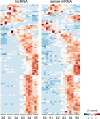Developmental Dynamics of Long Noncoding RNA Expression during Sexual Fruiting Body Formation in Fusarium graminearum
- PMID: 30108170
- PMCID: PMC6094484
- DOI: 10.1128/mBio.01292-18
Developmental Dynamics of Long Noncoding RNA Expression during Sexual Fruiting Body Formation in Fusarium graminearum
Abstract
Long noncoding RNA (lncRNA) plays important roles in sexual development in eukaryotes. In filamentous fungi, however, little is known about the expression and roles of lncRNAs during fruiting body formation. By profiling developmental transcriptomes during the life cycle of the plant-pathogenic fungus Fusarium graminearum, we identified 547 lncRNAs whose expression was highly dynamic, with about 40% peaking at the meiotic stage. Many lncRNAs were found to be antisense to mRNAs, forming 300 sense-antisense pairs. Although small RNAs were produced from these overlapping loci, antisense lncRNAs appeared not to be involved in gene silencing pathways. Genome-wide analysis of small RNA clusters identified many silenced loci at the meiotic stage. However, we found transcriptionally active small RNA clusters, many of which were associated with lncRNAs. Also, we observed that many antisense lncRNAs and their respective sense transcripts were induced in parallel as the fruiting bodies matured. The nonsense-mediated decay (NMD) pathway is known to determine the fates of lncRNAs as well as mRNAs. Thus, we analyzed mutants defective in NMD and identified a subset of lncRNAs that were induced during sexual development but suppressed by NMD during vegetative growth. These results highlight the developmental stage-specific nature and functional potential of lncRNA expression in shaping the fungal fruiting bodies and provide fundamental resources for studying sexual stage-induced lncRNAs.IMPORTANCEFusarium graminearum is the causal agent of the head blight on our major staple crops, wheat and corn. The fruiting body formation on the host plants is indispensable for the disease cycle and epidemics. Long noncoding RNA (lncRNA) molecules are emerging as key regulatory components for sexual development in animals and plants. To date, however, there is a paucity of information on the roles of lncRNAs in fungal fruiting body formation. Here we characterized hundreds of lncRNAs that exhibited developmental stage-specific expression patterns during fruiting body formation. Also, we discovered that many lncRNAs were induced in parallel with their overlapping transcripts on the opposite DNA strand during sexual development. Finally, we found a subset of lncRNAs that were regulated by an RNA surveillance system during vegetative growth. This research provides fundamental genomic resources that will spur further investigations on lncRNAs that may play important roles in shaping fungal fruiting bodies.
Keywords: Fusarium graminearum; Xrn1 exonuclease; fruiting body; long noncoding RNAs; perithecia; sexual development.
Copyright © 2018 Kim et al.
Figures







Similar articles
-
Transcriptome analyses during fruiting body formation in Fusarium graminearum and Fusarium verticillioides reflect species life history and ecology.Fungal Genet Biol. 2012 Aug;49(8):663-73. doi: 10.1016/j.fgb.2012.05.009. Epub 2012 Jun 15. Fungal Genet Biol. 2012. PMID: 22705880
-
A novel antisense long non-coding RNA participates in asexual and sexual reproduction by regulating the expression of GzmetE in Fusarium graminearum.Environ Microbiol. 2021 Sep;23(9):4939-4955. doi: 10.1111/1462-2920.15399. Epub 2021 Jun 29. Environ Microbiol. 2021. PMID: 33438341
-
XRN1-associated long non-coding RNAs may contribute to fungal virulence and sexual development in entomopathogenic fungus Cordyceps militaris.Pest Manag Sci. 2019 Dec;75(12):3302-3311. doi: 10.1002/ps.5453. Epub 2019 May 17. Pest Manag Sci. 2019. PMID: 31025499
-
Roles of long noncoding RNAs in brain development, functional diversification and neurodegenerative diseases.Brain Res Bull. 2013 Aug;97:69-80. doi: 10.1016/j.brainresbull.2013.06.001. Epub 2013 Jun 10. Brain Res Bull. 2013. PMID: 23756188 Review.
-
The filamentous fungus Sordaria macrospora as a genetic model to study fruiting body development.Adv Genet. 2014;87:199-244. doi: 10.1016/B978-0-12-800149-3.00004-4. Adv Genet. 2014. PMID: 25311923 Review.
Cited by
-
Integrative Activity of Mating Loci, Environmentally Responsive Genes, and Secondary Metabolism Pathways during Sexual Development of Chaetomium globosum.mBio. 2019 Dec 10;10(6):e02119-19. doi: 10.1128/mBio.02119-19. mBio. 2019. PMID: 31822585 Free PMC article.
-
A novel lncRNA as a positive regulator of carotenoid biosynthesis in Fusarium.Sci Rep. 2020 Jan 20;10(1):678. doi: 10.1038/s41598-020-57529-2. Sci Rep. 2020. PMID: 31959816 Free PMC article.
-
Functional analysis of long-chain non-coding RNA in oral squamous cell carcinoma.Transl Cancer Res. 2020 Jan;9(1):249-261. doi: 10.21037/tcr.2019.12.67. Transl Cancer Res. 2020. PMID: 35117179 Free PMC article.
-
Transcription factor-dependent regulatory networks of sexual reproduction in Fusarium graminearum.mBio. 2025 Jan 8;16(1):e0303024. doi: 10.1128/mbio.03030-24. Epub 2024 Nov 26. mBio. 2025. PMID: 39589130 Free PMC article.
-
Comparative Genomics and Transcriptomics During Sexual Development Gives Insight Into the Life History of the Cosmopolitan Fungus Fusarium neocosmosporiellum.Front Microbiol. 2019 Jun 7;10:1247. doi: 10.3389/fmicb.2019.01247. eCollection 2019. Front Microbiol. 2019. PMID: 31231336 Free PMC article.
References
-
- Guttman M, Amit I, Garber M, French C, Lin MF, Feldser D, Huarte M, Zuk O, Carey BW, Cassady JP, Cabili MN, Jaenisch R, Mikkelsen TS, Jacks T, Hacohen N, Bernstein BE, Kellis M, Regev A, Rinn JL, Lander ES. 2009. Chromatin signature reveals over a thousand highly conserved large non-coding RNAs in mammals. Nature 458:223–227. doi:10.1038/nature07672. - DOI - PMC - PubMed
-
- Kapranov P, Cheng J, Dike S, Nix DA, Duttagupta R, Willingham AT, Stadler PF, Hertel J, Hackermüller J, Hofacker IL, Bell I, Cheung E, Drenkow J, Dumais E, Patel S, Helt G, Ganesh M, Ghosh S, Piccolboni A, Sementchenko V, Tammana H, Gingeras TR. 2007. RNA maps reveal new RNA classes and a possible function for pervasive transcription. Science 316:1484–1488. doi:10.1126/science.1138341. - DOI - PubMed
Publication types
MeSH terms
Substances
LinkOut - more resources
Full Text Sources
Other Literature Sources
Molecular Biology Databases

